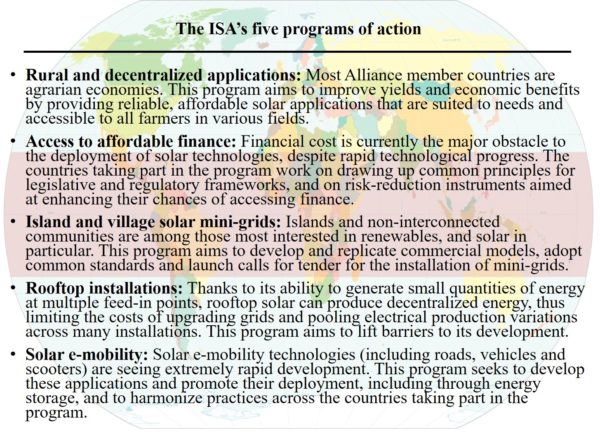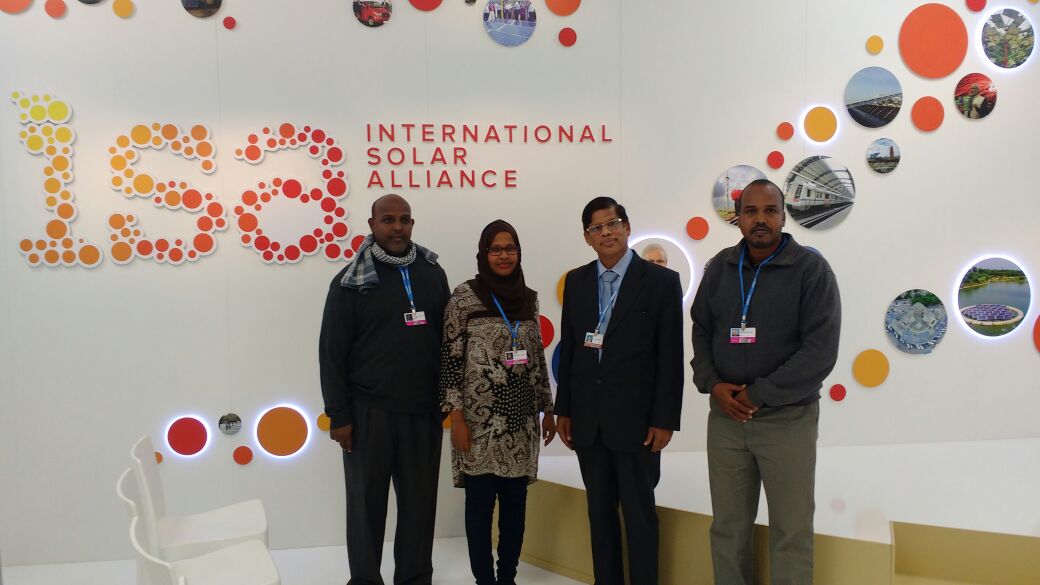The International Solar Alliance (ISA) is an inter-governmental body, first to be headquartered in India. Moreover, ISA has been registered (No. 54949) under the United Nations (UN) under article 102 of the UN charter, with effect from February 9, 2018.
ISA was launched jointly by the Indian Prime Minister and the French President during COP21 held in December 2015 in Paris, France. It aims to contribute to the implementation of the Paris Climate Agreement through rapid and massive deployment of solar energy. ISA also contributes to the 12 commitments of the One Planet Summit.
ISA has organized and participated in several important events across the world, since it is established to spread its message of solar usage. However, since its legal formation on December 6, 2017 the body could not organize the founding ceremony, where all the important dignitaries be present together on a common date. Therefore, now ISA has found one day, March 11, 2018 to organize its founding ceremony in the presence of French President Emmanuel Macron, Indian Prime Minister Narendra Modi and Secretary General of the UN, António Guterres. Other major representative and dignitaries of ISA member countries will be presented at the event.
According to the alliance norm, the first 15 countries who have ratified the ISA framework agreement will become the founding members of the ISA and thus hold special responsibility in the alliance. They are: Bangladesh, Comoros, Fiji, France, Ghana, Guinea, India, Mali, Mauritius, Nauru, Niger, Seychelles, Somalia, South Sudan, and Tuvalu.
What will happen at the ISA summit 2018?
More than 20 Heads of State and Government, and representatives of international organizations, development banks, the private sector and civil society are meeting to speed up the implementation of the Alliance and achieve concrete results in terms of access to energy and combating global warming.
- General mobilization of government, international and private actors
- Mobilization of ISA member countries to implement the alliance.
- Commitments from international organizations.
- Mobilization of the private sector with the creation of a committee of businesses.
- Promotion of solar energy research and innovation
- Creation of a network of Solar Resource centers in the 121 countries of the ISA region, under Solar Technology Applications & Resource Centre (STAR-C).
- Establishment of training programs intended to all actors of this sector, including 10,000 young technicians to be trained in 5 years.
- Development of partnerships fostering technology transfer and innovation.
- Launching of Solar Awards & Fellowships.
- Implementation of concrete instruments
- Fostering of the transfer of knowledge and information through the launch of a collaborative “Infopedia” online platform.
- Publication of a practical guide to ensure high-quality standards.
- Publishing online of standard documents to facilitate the purchasing of electricity in public tenders and supply processes.
- Establishment of STAR-C
- Financing of new solar energy projects
- Financial commitments by public and private stakeholders
- Support for 121 initial projects
- Creation of a common guarantee mechanism
- Development of a “single window” platform to bring together project developers and investors
What has happened since COP21?
- 60 Countries have joined the Alliance, which obtained the status of an international organization on 6 December 2017.
- Five programs of action have been launched on rural and decentralized applications, finance, mini-grids, rooftop installations and solar e-mobility.

The ISA’s five solar programs of action. Image: pv magazine; Source: ISA; Background Image: CIA World Factbook/wikipedia
- Six meetings of the ISA international Steering Committee have been held, co-chaired by France and India.
- Forums to bring together private sector provision, finance and solar energy demand have been organized in Paris and New Delhi.
- 100 first projects for solar applications have been identified from 34 ISA member countries.
- A common financial guarantee mechanism is being established to foster affordable access to finance.
- ‘Action to Transaction’ meets to bring Stakeholders together.
Why ISA is formed?
ISA aims to bring together the 121 sun-rich states located between the Tropics of Cancer and Capricorn to provide a collective response to the most common obstacles to the massive deployment of solar energy in terms of technology, finance and capacity. The aim is to raise the trillion dollars needed to develop 1 terawatt of solar energy capacity by 2030.
The countries located between the two tropics are, for the great majority, developing ones. 20-50% of their populations do not have access to electricity. They also represent: 73% of the global population; 36% of world GDP; 55% of total energy consumption worldwide; and only 23% of installed solar capacity.
Around 60 countries that have joined the ISA represent a combined potential to develop 138 GW of solar capacity in the next five years, according to the International Energy Agency (IEA). As of March 1, out of 60 countries 26 have ratified the ISA framework agreement.
Solar energy has an important role to play in ensuring a sustainable energy future and displays an enormous potential: in 90 minutes, the solar energy striking the Earth would be sufficient to provide the entire planet’s energy needs for one year.
The costs of solar photovoltaic modules have fallen by around 80% since the end of 2009, making it one of the cheapest sources for electricity generation, especially in countries between the tropics.
Thanks to cost decrease and technology improvement, solar photovoltaics is currently the fastest-growing source of electricity globally. Worldwide solar capacity rose for the first time faster than any other source of electricity in 2016: 74 GW of new capacities were built reaching almost 300 GW in total capacity.
Additionally, ISA is also organizing its second National Focal Point Conclave from March 10 – March 18, 2018 in New Delhi. The main objective of the conclave is to develop road maps for Solar Energy Programs of individual ISA member countries. Earlier, the first NFP Conclave was held in December 2017 in New Delhi.
This content is protected by copyright and may not be reused. If you want to cooperate with us and would like to reuse some of our content, please contact: editors@pv-magazine.com.








By submitting this form you agree to pv magazine using your data for the purposes of publishing your comment.
Your personal data will only be disclosed or otherwise transmitted to third parties for the purposes of spam filtering or if this is necessary for technical maintenance of the website. Any other transfer to third parties will not take place unless this is justified on the basis of applicable data protection regulations or if pv magazine is legally obliged to do so.
You may revoke this consent at any time with effect for the future, in which case your personal data will be deleted immediately. Otherwise, your data will be deleted if pv magazine has processed your request or the purpose of data storage is fulfilled.
Further information on data privacy can be found in our Data Protection Policy.